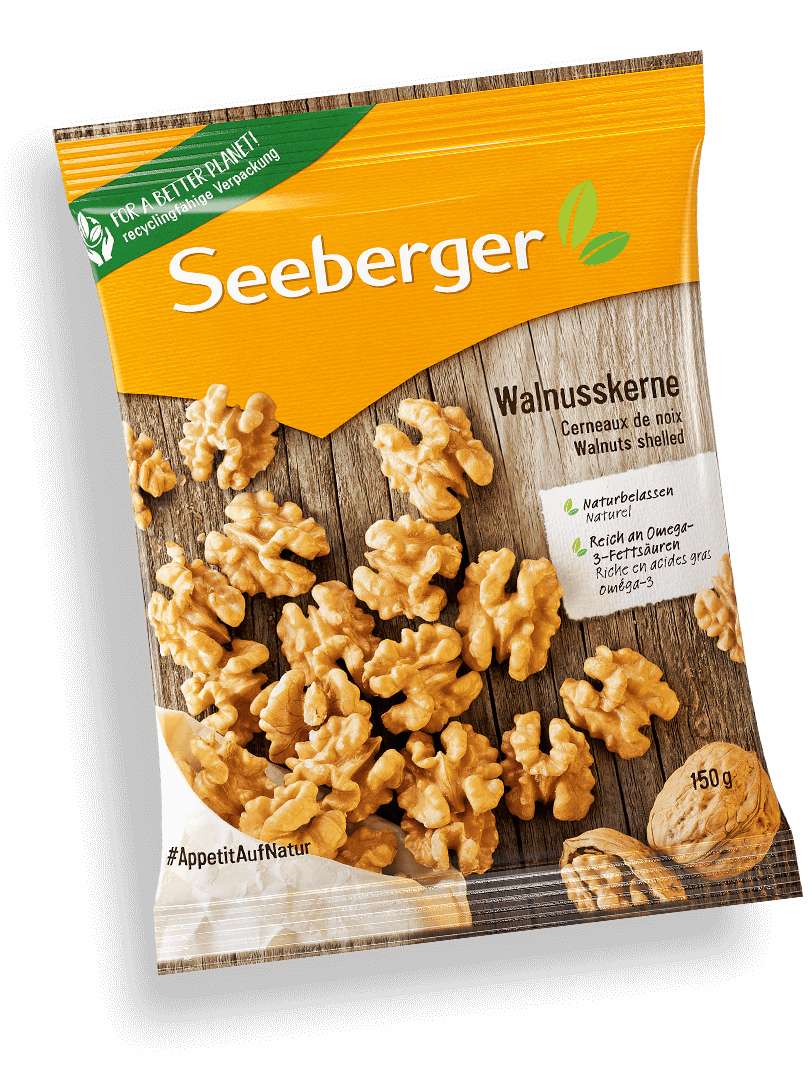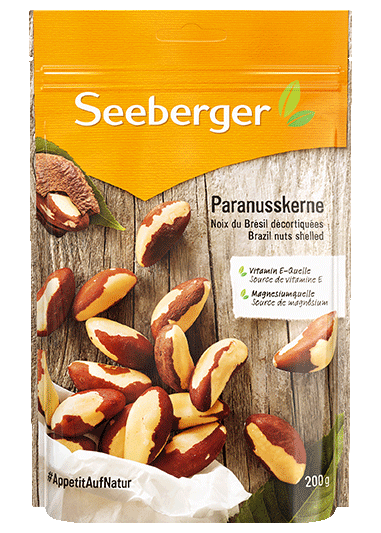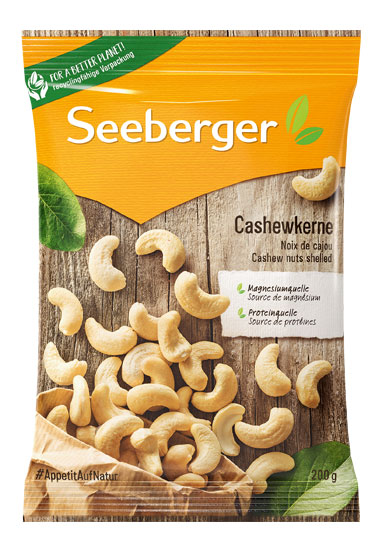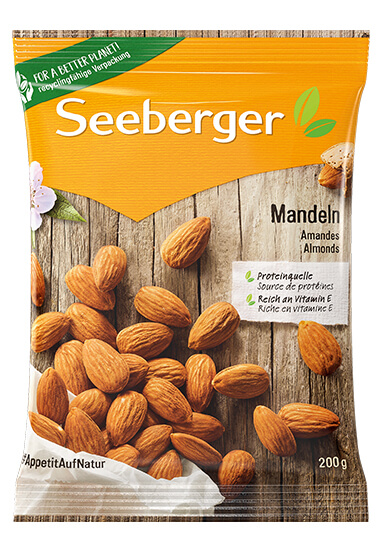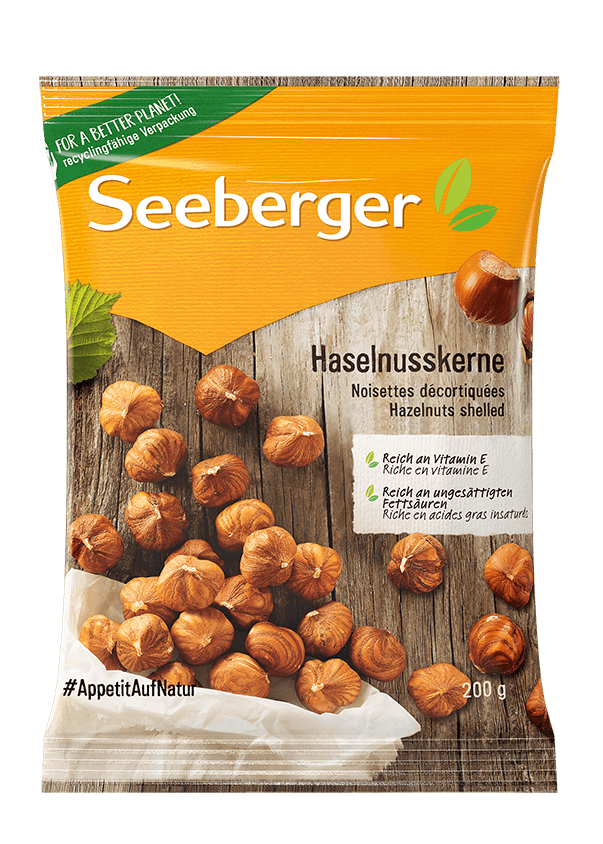Walnuts
Product information
If you prefer to enjoy your walnuts straightaway without having to crack them first, then our shelled walnuts are the right choice: extra light and large nuts, which we source and transport carefully from Chile and the USA, ensuring a low percentage of breakage. With their aromatic, slightly buttery flavour, they not only make a great snack, but are also an excellent finishing touch in muesli or fruit salad – or the very best nut cake following grandma’s recipe!
Ingredients
Walnuts
Nutrition Statement
Rich in Omega-3 fatty acids, rich in polyunsaturated fatty acids, source of fibre
This product is
- vegetarian
- vegan
- glutenfree*
- lactosefree*
- no added sugar**
- no added salt***
Nutrition facts
(per 100g)
- Calories (kj/kcal) 2.957 kj/717 kcal
- Fat 69 g
- of which saturated fatty acids 6,4 g
- Carbohydrate 6,0 g
- of which sugar ** 2,6 g
- Protein 14 g
- Salt *** < 0,01 g
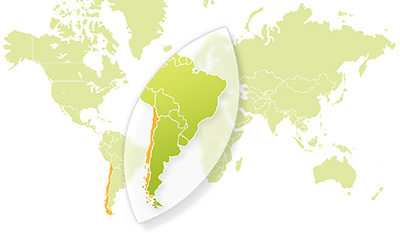
COUNTRY OF ORIGIN: CHILE
Chile's nature is stamped by its enormous yet narrow expanse from north to south. More than 3,500 km separate Chile's northern border with Peru and its southernmost point at Cape Horn. The region enjoys a Mediterranean climate – perfect for growing walnuts and plums, among other fruits. It is significantly influenced by the Humboldt Sea Current, which carries cold water up from Antarctica.
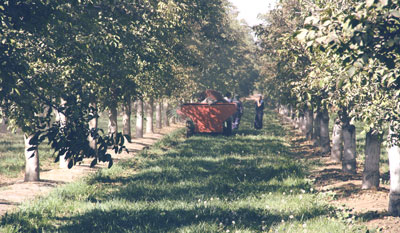
GROWING WALNUTS
Walnuts are grown on large plantations under the Chilean sun, planted in neat rows. If the spacing between the trees is too great, they tend to bear fewer walnuts. Did you know that walnut trees do not need bees for pollination? With these big trees, the pollen arrives – just as naturally and yet almost invisibly – on the wind.
Our partners growing walnuts in Chile respect the natural crop rotation. In the interest of biodiversity, plums, peaches, avocados and raisins, for example, are grown on the original walnut plantations once the trees have become less productive and the ground has been left to stand fallow for some years before walnuts can again be grown on them.
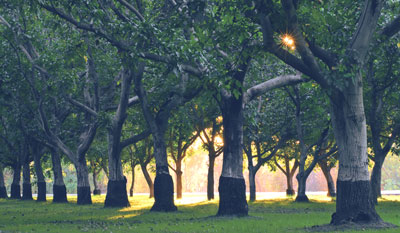
WALNUT TREE
Did you know that walnut trees are true giants? On average, they grow to be 10 meters in height. It takes about seven years for the trees to bear enough nuts for an economically viable crop. On the most productive trees, nuts continue to ripen for up to 35 years. Only then are they replaced by younger trees. The high-quality walnut wood is sought after for its beautiful grain and is used, for example, for furniture or car veneers. This is not the only ingredient that is recycled. The green husks that enclose the walnuts are composted after harvesting.
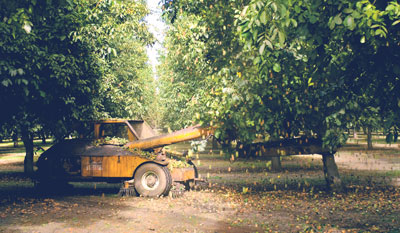
WALNUT HARVEST
The nuts are harvested in March and April, in the Chilean autumn. First, the trees are shaken with a vibrator and the walnuts fall onto the surrounding ground. Some of the nuts are still partially enclosed by a green husk. The walnuts are then gathered between the rows and collected from the ground with a large suction machine.

PROCESSING THE WALNUTS
The first quality control gets underway as soon as the freshly harvested walnuts are delivered to the local processing plant. During the hulling that follows, the green hull and other natural impurities are removed from the product. The walnuts are then taken into large drying rooms and carefully dried over hot air within 48 hours to prolong shelf life and to preserve the lightness of color.
To extract the valuable kernels, which can be found as a product on their own and in a variety of our products such as our nut kernel mix, the walnuts must be cracked. In the past, the walnuts were cracked by hand. Today, they are gently handled by machines. Quite the savings in labor, given that Chile alone harvests over 100,000 tons of walnut kernels a year.
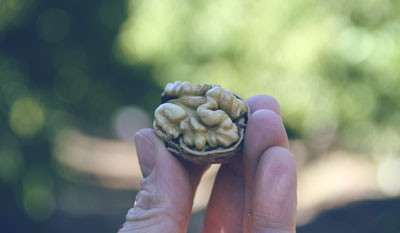
QUALITY CHARACTERISTICS
The decisive criteria for the classification and therefore the price are the size and color of the walnut kernels. We prefer the large, light-colored kernels. Another important factor is the intactness of the kernels. Our walnut halves are almost entirely undamaged and suffer hardly any abrasion or breakage. This also has an additional positive side effect: If the fine membrane of the kernel is present and suffers little breakage or abrasion, the walnut is naturally protected from oxygen, which is positively reflected in the taste. Another advantage from being grown in Chile: The walnut kernels are particularly mild thanks to the climate.
Before the walnuts are shipped to us in Ulm, they pass through several quality controls. These include modern laser checks, metal detectors and manual inspections by experienced employees. Within 6–8 weeks of the harvest, the first walnut kernels arrive at our plant in Ulm in oxygen-protected transport boxes.

QUALITY CONTROL IN ULM
The final control of the walnuts is carried out here at our headquarters in Ulm by our in-house food chemistry laboratory. Our tests check the shape, color, breakage, taste, size, aroma, and consistency. Each lot is tasted in our sensory lab.
Only when the last test has been successfully passed do we package the product or put it into mixtures, such as our popular trail mix.

PARTNERSHIP
In addition to the strict requirements of size, taste and color of the natural products, the personal contact as well as the impression on site is also decisive for us. Our managing director Ralph Beranek and our longtime buyer Andreas Heigele made the long journey to the Andean state to visit our local partners and to talk things over with them. We are proud to have found reliable partners in Chile, some of whom we have been working with for over 20 years. The company philosophy of our supplier accords with our own. Our business relationship is oriented towards sustainability, not short-term profits. For example, the prices agreed are valid for a complete harvest year.
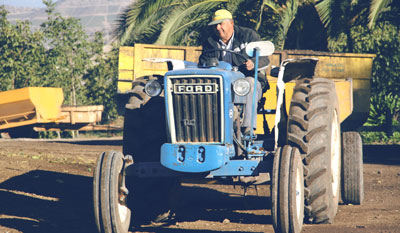
FAIR WORKING CONDITIONS
As an emerging economy, it is becoming increasingly important for Chile to find, and above all retain, a good workforce. Our local partner and the farmers that deliver the walnuts are developing measures to improve working conditions in the value chain. For example, the employees are picked up at collection points by company-owned buses. Recreation rooms are available for breaks, and childcare is available for working mothers. Meals during working hours are provided by our partner. In addition, the factory halls are air-conditioned, and to reduce noise, noisy work steps such as the nut-cracking machines are relocated to separate halls.
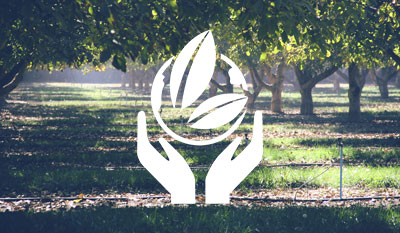
SUSTAINABILITY
The measures our partners have taken to promote sustainability are particularly positive. In some areas of Chile, water scarcity is a major problem. Measures have been taken at such sites to reduce water consumption. In the past, some of the plantations were entirely flooded – a very cost-effective but extremely inefficient use of water. Today, irrigation water is fed to the trees with pinpoint accuracy using sophisticated systems. Not a drop is wasted now.
When designing a large new plantation, care was taken to allow some typical Chilean trees already on the site, some up to 200 years old, to stay. Fertilizer and pesticide use there, moreover, is limited to the absolutely necessary.
 Walnuts: fully shelled walnuts | Seeberger GmbH
Walnuts: fully shelled walnuts | Seeberger GmbH
